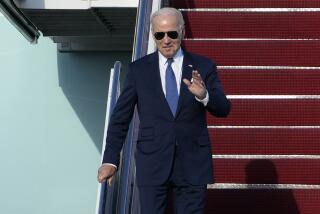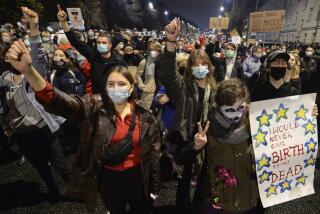Beyond a Fallen Curtain, Heavy Tasks : East Europe: To build on the revolutions of 1989, the West must no longer stand and watch. But when it pitches in to help, the response must be enlightened.
- Share via
OXFORD, England — The West was content in 1989 to stand by and cheer the destruction of the Iron Curtain. Now its disappearance means that we have to actively help stabilize the difficult process of transition to economic and political democracy in a region vital to the development of a new Europe.
The difficulties of transition stem from the very phenomena that paved the way for revolution: political decay and economic crisis.
Future democratic administrations will have to build a new civil service through which to govern. These new administrations will also have to learn on the job. After 40 years of dictatorship, most people with government experience lack public credibility. The lack of association with government is now a strong qualification for elective office.
Problems of political inexperience are compounded by ones of political fragmentation. In a natural reaction to one-party rule, political parties are mushrooming throughout the region (Hungary now boasts 47). At present, major political groups seem willing to cooperate in what are recognized as national emergencies. But these temporary, composite fronts, including both Communists and opposition, will give way this year through elections to what will probably be volatile array of coalition governments.
This shifting political base will make it difficult for governments to deal with the legacy of economic crisis. All these countries face the daunting task of transforming ramshackle administered economies into ones responding to market forces. The political honeymoons will predictably be very short. People will use the polling booth to defeat parties that fail to deal with inflation and keep shops supplied.
It is in aiding new governments to deliver the economic goods that the West can most directly help to stabilize the transition to democratic rule. After a slow and piecemeal start, Western governments are beginning to make more substantive and coordinated moves. But political democracy can work against as well as for economic rationalization. Neither the International Monetary Fund nor other Western agencies should assume that East European economies will all easily become free-market systems. In these populations accustomed to extensive welfare nets and resistant to unemployment, the ‘90s will probably see the emergence of hybrid, mixed-ownership systems.
The speed and shape of change will of course differ from country to country. Poland is perhaps among the most receptive to large-scale privatization, although overall economic performance will probably be very uneven. Hungary is likely to improve living standards faster, while East Germany and Czechoslovakia, with their developed industrial traditions, may reach Western levels within five to eight years.
The very different speeds at which East European states will develop economically (and indeed politically) point up the likelihood of a far more complex development of the economic and political landscape than some West European politicians now envisage. They tend to think in terms of all East European states belonging to an outer circle of economies grouped in some kind of body removed from, but loosely associated with, the European Community. It is more realistic to see some of the Central European states--East Germany (clearly a special case), Hungary and Czechoslovakia--as oriented toward, if not affiliated with, the European Community, while others--Poland, Bulgaria and Romania--continue economic ties mainly with their neighbors.
To some extent a similarly mixed picture of East European alignment is likely to emerge on the diplomatic and security front. With non-Communist majorities in power in several East European states and Soviet President Mikhail S. Gorbachev adhering to what has amounted to a laissez-faire policy in Eastern Europe, the Warsaw Pact clearly has to change to avoid disintegration. Moscow proclaims that it wishes to transform this military alliance into a political one. Yet it is more difficult to forecast such an evolution. National interest and democratic pressures in Czechoslovakia and Hungary could conceivably push those states toward neutrality. This would probably be regretted yet reluctantly accepted by a leadership in Moscow hoping to Finlandize relations with former satellites. Poland, notwithstanding its strong anti-Russian traditions, will be inclined by national anxieties about Germany to reach a new accommodation with the Soviet Union. National interest thus may well help to build a new looser political Warsaw Pact including Poland, Bulgaria (perhaps Romania) and even Czechoslovakia and Hungary as associate members with status equivalent to that of France in the North Atlantic Alliance.
Where East Germany fits into the picture poses the greatest problem, one that can be resolved only within the wider context of new security, political and economic structures for Europe as a whole. It is the German question, as well as their own economic and political aspirations, that makes East Europeans, and many Soviets, enthusiastic pan-Europeans. They see more active and wider European cooperation and integration as the only way of managing the seemingly ineluctable coming together of the two Germanys by enveloping the process within one of creating a new Europe.
The two alliance systems would seem to be essential scaffolding for the building of this new Europe, gradually dismantled only when the new economic, political and security arrangements can take the full weight of the structure. At present there seems to be a remarkably strong consensus on all sides that NATO and the Warsaw Pact need one another, as well as a stronger and broader Helsinki process, in order to cope with the problems of transition to a new Europe of which the countries of Central and Eastern Europe form the most volatile and most vital element. It will need an enlightened Western policy of economic aid as well as flexible coordination of political and security strategies to build on the revolutions of 1989 and transform Eastern Europe from a divide within the old Europe into a bridge for the new.
More to Read
Sign up for Essential California
The most important California stories and recommendations in your inbox every morning.
You may occasionally receive promotional content from the Los Angeles Times.










